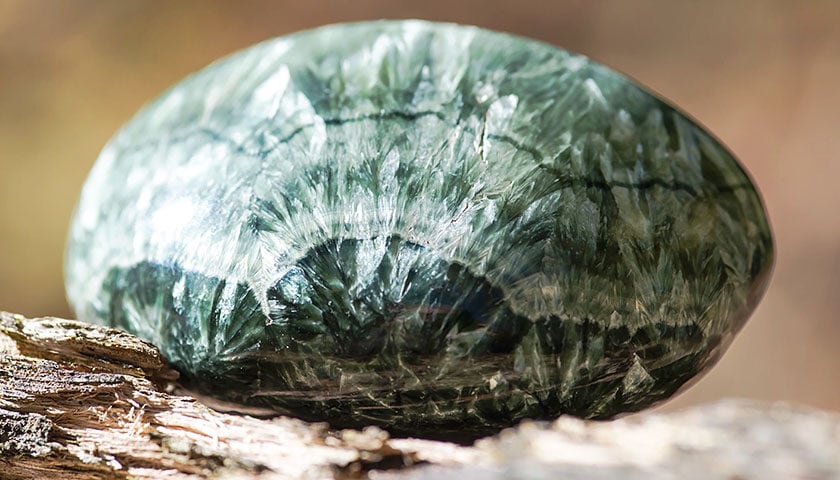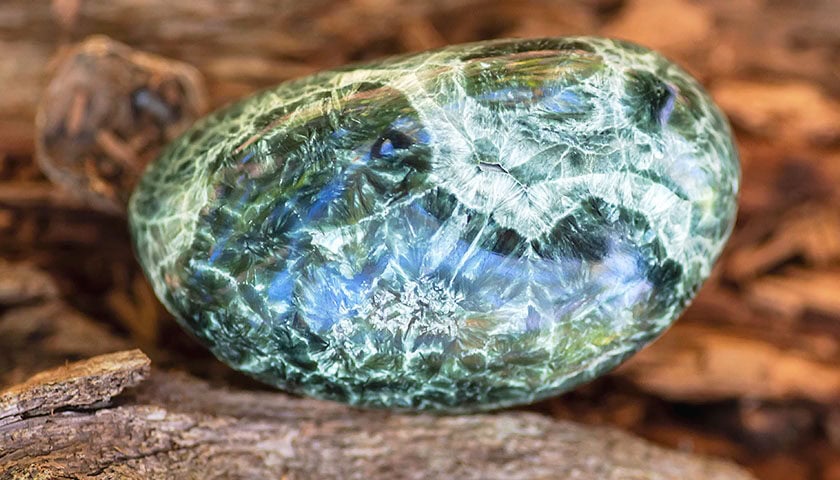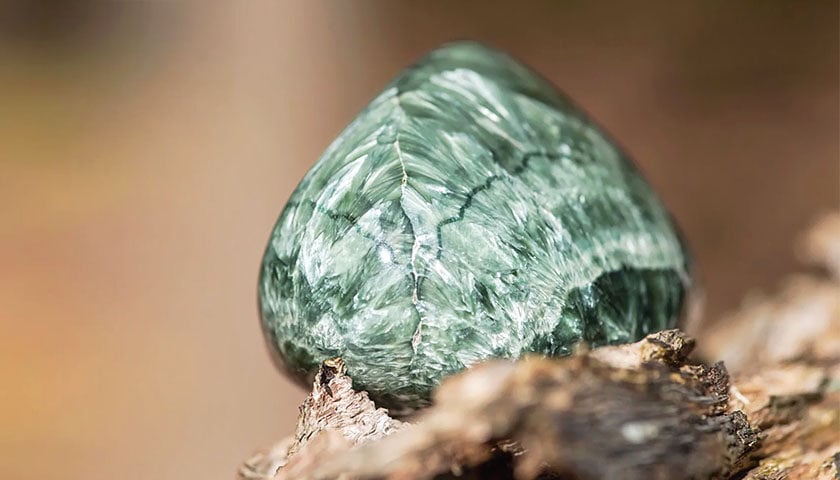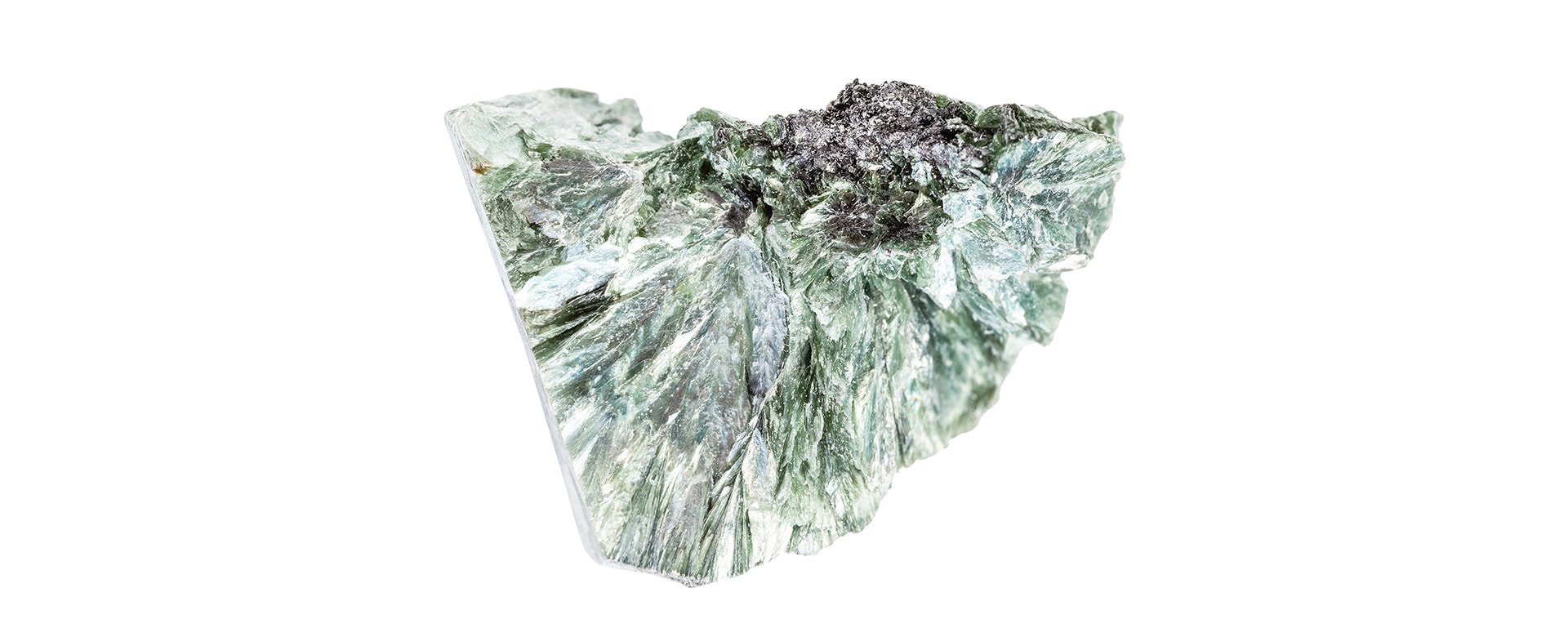Article Highlights
Seraphinite, a gemstone shrouded in celestial mystery, stands out in the mineral world with its deep forest green hues and mesmerizing silvery patterns. Often referred to as green chlorite, this fine-grained gemstone belongs to the chlorite group and captivates onlookers with its unique, feather-like mica inclusions. Rarely, seraphinite may also present itself in striking shades of red, yellow, gold, or black, making each piece a unique treasure of the Earth.
The name ‘seraphinite’ derives from the Greek word ‘seraphim,’ referring to winged heavenly beings. This connection is no mere coincidence; the gemstone’s iridescent fibers resemble silver, feathery wings encapsulated within a deep, forest green matrix, symbolizing a direct link to the celestial realm. As we delve into the world of seraphinite, prepare to be transported to a place where beauty and mysticism intertwine, offering a glimpse into the angelic.
About Seraphinite Stone

A Unique and Beautiful Gem
Seraphinite isn’t just any gemstone; it’s a testament to nature’s artistry. As a semi-precious stone, seraphinite boasts a unique beauty, often overlooked for more conventional choices. Its deep, verdant tones and shimmering silver accents offer an elegance unmatched by other gems. While not traditionally used in mainstream jewelry due to its relative softness, seraphinite has become a cherished collector’s item and a jewel for those who dare to stand out.
Celestial Associations and Alternative Names
Beyond its physical allure, seraphinite carries a celestial significance. Although not an official zodiac stone, it resonates profoundly with Sagittarius, the seeker of truth. Sagittarians find a spiritual ally in seraphinite, aiding in their quest to bridge the physical and divine realms. The stone’s feminine energies also offer a harmonious balance to Sagittarius’ fiery nature.
Known by various names such as serafine, green clinochlore, and chlorite jade, seraphinite is most affectionately dubbed the “Stone of Angels.” This nickname speaks volumes about the stone’s powerful spiritual energy, believed to facilitate communication with higher planes and invoke the protection and guidance of the angelic realms.
Visual Splendor
Imagine holding a piece of the celestial canopy in your hands – that’s the allure of seraphinite. With its predominant deep green coloration resembling the richest emerald forests, seraphinite also offers glimpses of translucency where light dances through its silvery inclusions. Each stone tells its own story through patterns that evoke a sense of divine presence and mystical journeying.
Seraphinite Specifications & Characteristics

A Symphony of Elements
Seraphinite isn’t just pleasing to the eye; it’s a marvel of geological composition. At its heart, seraphinite is a Mg5 Al(AlSi3 O10)(OH)8, a complex aluminosilicate of magnesium and iron that belongs to the Phyllosilicates mineral family. This intricate dance of elements results in a stone with a unique set of physical and optical properties that captivate and intrigue.
A Palette of Nature’s Greens
The color of seraphinite is a testament to nature’s artistry. Ranging from the darkest forest greens to lighter shades, occasionally interspersed with touches of yellow, gold, red, black, and white, each seraphinite gemstone is a unique piece of the Earth’s canvas. Its primary hue, reminiscent of lush foliage and the depths of the ancient forests, invites a sense of calm and connection to nature.
Unique Physical Properties
Seraphinite’s charm lies not just in its appearance but also in its physical characteristics. While it shares a monoclinic crystal structure with many other minerals, it presents perfect cleavage in one direction, making it a delight for collectors and a challenge for jewelers. Its relatively soft nature, with a Mohs hardness of 2-2.5, demands care and respect, ensuring that each piece is treated as the precious entity it is.
The stone’s luster, ranging from pearly to vitreous, adds to its ethereal appeal, creating a surface that seems to glow from within. Translucent to opaque, seraphinite is a gemstone that captures the light in unique ways, highlighting the feathery inclusions that give it its heavenly name. Its refractive index and specific gravity tell a story of light and density, adding depth and dimension to this already complex gem.
Seraphinite Meaning & History

A Gemstone with a Rich Legacy
Discovery and Naming
Seraphinite’s journey begins near the serene shores of Lake Baikal in Siberia, where Russian mineralogist Nikolay Ivanovich Koksharov first discovered this enchanting stone. Its name, derived from the celestial seraphim, reflects its heavenly patterns that resemble ethereal wings. Dating back approximately 20-25 million years, Lake Baikal’s ancient waters have cradled this gem, contributing to its mystical allure and making it a stone of ancient wisdom and profound earth history.
Global Recognition and Spiritual Significance
While initially found in the icy realms of Russia, seraphinite has touched corners of the globe, from the United States to Europe, each location adding to its tapestry of lore and appeal. Despite its varied locations, the finest specimens hail from its Siberian homeland, making it a treasured rarity in the gem world. Seraphinite’s connection to the Greek goddess Persephone and the Christian Seraph angels weaves a rich narrative of rebirth, growth, and divine presence, underscoring its deep spiritual resonance across cultures and ages.
A Stone of Celestial Connection
Symbolism and Energy
Seraphinite isn’t merely a stone to behold; it’s an experience to embrace. Its silvery patterns do more than dazzle the eye; they serve as conduits to higher planes, offering protection, guidance, and a deeper understanding of the celestial realm. The Seraph, a high-ranking angelic being, is said to be reflected in seraphinite’s intricate patterns, reminding us of the stone’s divine origin and purpose.
The Interplay of Science and Spirit
As we marvel at seraphinite’s beauty, we also recognize the intricate dance of science and spirit that it represents. Its geological formation, a testament to Earth’s dynamic processes, meets a tapestry of spiritual meanings and connections, making seraphinite a stone that bridges worlds and invites us to explore the mysteries of both the visible and invisible realms.
Seraphinite Healing Properties

A Stone of Physical, Emotional, and Spiritual Wholeness
Physical Healing Energies
Seraphinite’s reputation as a powerful healing stone is not just folklore; it’s an experience shared by many who have felt its gentle yet profound energy. Believed to aid the heart and lungs and support cellular regeneration, seraphinite is a balm for the body, offering physical healing and a boost to overall vitality. Its influence on cellular respiration and nutrient delivery speaks to its role as a stone of life and growth, echoing the natural world from which it comes.
Emotional Healing and Balance
In the realm of emotional healing, seraphinite shines brightly. As the “Stone of Angels,” it brings a calming, uplifting energy that stabilizes the spirit and soothes the heart. Its ability to release emotional patterns that no longer serve us invites a journey of healing and personal growth, guiding us towards a path of inner peace and emotional equilibrium. Seraphinite’s nurturing energy is a reminder that we are never alone, always supported by the unseen hands of the celestial realm.
Chakra Alignment and Spiritual Awakening
Seraphinite’s magic extends into the spiritual domain, where it is revered as a tool for chakra alignment and awakening. Known to activate and harmonize all chakras, with a particular affinity for the heart chakra, seraphinite is a key to unlocking the doors of spiritual exploration. It invites the Kundalini energy to rise, clearing and stimulating the energy centers of the body and fostering a sense of divine connection and inner harmony.
Types of Seraphinite
Seraphinite, with its ethereal beauty and profound energy, presents itself in a variety of shades and types, each holding its own unique qualities and energies. While the classic deep forest green seraphinite is the most well-known, other colors offer their own rare and captivating beauty.
A Spectrum of Heavenly Hues
Green Seraphinite
The most common and beloved form of seraphinite is characterized by its rich, deep green color interspersed with shimmering silver or white patterns. These patterns, reminiscent of angelic wings, are what give seraphinite its heavenly appearance and name. The green seraphinite is not just a visual delight; it’s also a powerful tool for emotional and spiritual healing, resonating strongly with the heart chakra.
Black Seraphinite
Black seraphinite is a rarer variety, offering a dark, grounding presence. It shares the feathery, silver inclusions of its green counterpart but does so against a striking black backdrop. This type is often sought after for its protective qualities and its ability to facilitate deeper, more profound connections with the spiritual realm.
Red Seraphinite
An extremely rare and sought-after variety, red seraphinite displays a warm, vibrant hue. Its red coloration is believed to be due to the presence of chromium and can range from pale pink to deep red. This type of seraphinite is associated with an energizing and revitalizing energy, often connected to the root and sacral chakras, stimulating vitality and passion.
The Meaning Behind the Colors
Each color variation of seraphinite not only adds to its visual appeal but also brings its own set of metaphysical properties and energies. The green varieties are often associated with growth, healing, and a connection to nature, while the black types provide grounding and protective energies. Red seraphinite, with its rare presence, is typically linked to vitality, passion, and a stronger connection to the physical realm.
Nurturing Growth and Connection
No matter the type, seraphinite remains a stone deeply connected to the spiritual and the divine. Its various hues and patterns serve as a reminder of the diversity and beauty of the natural world and the many ways in which we can connect to the energy around us. Whether seeking healing, protection, or a deeper spiritual connection, there’s a type of seraphinite to aid in your journey.
Seraphinite Formation & Sources

The Geological Marvel
Formation Process
Seraphinite’s journey from the Earth’s crust to your collection is a fascinating tale of geological processes. This stunning gemstone is a variety of clinochlore, a mineral belonging to the chlorite group, and forms through the metamorphic and hydrothermal alterations of magnesium and iron silicates. The conditions under which seraphinite forms are a precise dance of pressure, temperature, and chemical interactions, leading to the creation of its unique, feathery inclusions and mesmerizing green hues.
Primary Sources
While seraphinite can be found in various locations worldwide, the most prized specimens come from the Lake Baikal region of Siberia, Russia. This remote and rugged terrain is the only place where gem-quality seraphinite is mined, making it a rare and treasured find. Other minor deposits have been identified in locations like Turkey, Austria, Switzerland, Italy, and the United States, but none match the quality and beauty of the Siberian stones.
Seraphinite Gemstone Properties & Value
A Stone Like No Other
Unique Aesthetic and Physical Properties
Seraphinite’s value lies not only in its rarity but also in its unique aesthetic and physical properties. Its deep green color, laced with reflective mica inclusions, creates a mesmerizing effect that’s unlike any other gemstone. Its monoclinic crystal structure and perfect cleavage in one direction add to its distinctiveness and desirability.
Determining Factors of Value
The value of seraphinite is influenced by several factors including color, clarity, cut, and overall quality. Stones with a deep, vibrant green color and clear, well-defined silvery patterns are the most sought after and command higher prices. The cut of the stone also plays a significant role; well-crafted pieces that highlight the stone’s natural beauty and chatoyancy will be more valuable.
Affordability and Availability
Despite its rarity, seraphinite remains relatively affordable compared to other gemstones. This accessibility makes it an appealing choice for collectors and enthusiasts alike. However, as demand grows and supplies become more limited, its value may increase over time.
Seraphinite Care and Maintenance
Preserving Your Heavenly Stone
Handling with Care
Seraphinite’s relative softness (with a Mohs hardness of 2-2.5) requires careful handling to maintain its beauty. It’s prone to scratching and damage if not treated with care. Always store your seraphinite separately from harder gemstones and avoid exposing it to harsh chemicals or extreme temperatures.
Cleaning and Maintenance
To clean your seraphinite, use lukewarm water and a mild soap, gently wiping it with a soft cloth. Avoid ultrasonic cleaners and steamers, as these can damage the stone. Regularly cleaning and properly storing your seraphinite will ensure it remains a treasured piece for years to come.
Conclusion
A Celestial Journey
Seraphinite is more than just a gemstone; it’s a celestial journey encapsulated in mineral form. From its mystical formation deep within the Earth to its final, polished beauty, seraphinite invites us to connect with the divine and explore the deeper realms of healing and spirituality. Its rarity and unique properties make it a prized possession for collectors and a meaningful gem for those seeking spiritual growth.
As we conclude our exploration of seraphinite, remember that this stone is a bridge between heaven and Earth, offering a tangible connection to the angelic realms and the healing energies of the natural world. Whether you’re drawn to its physical beauty or its metaphysical properties, seraphinite is a gemstone that will surely enrich your life and inspire your spiritual journey.



